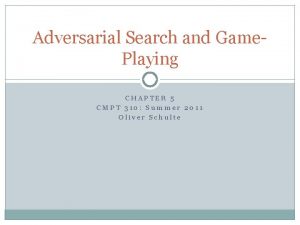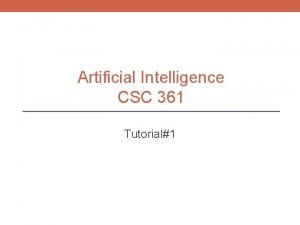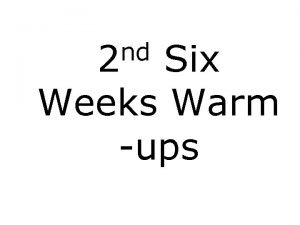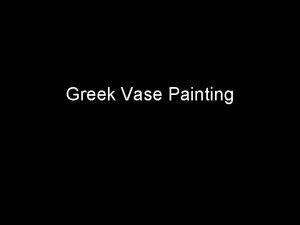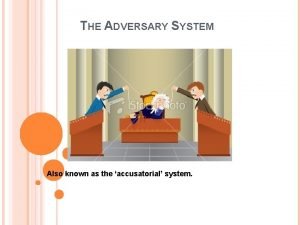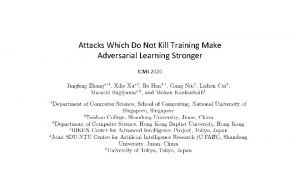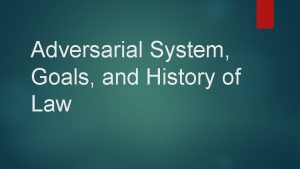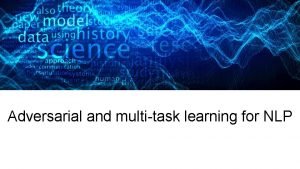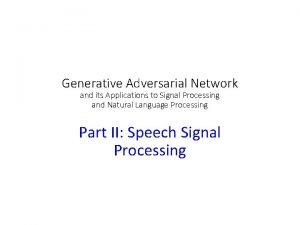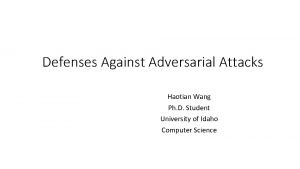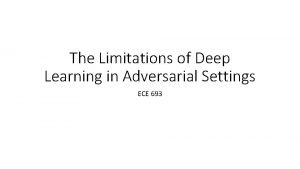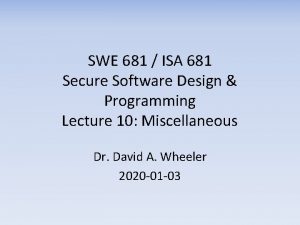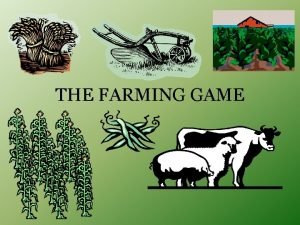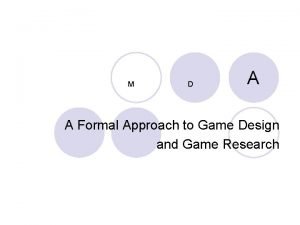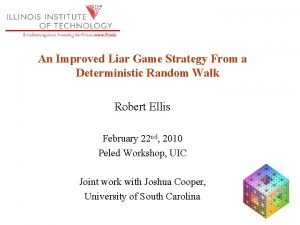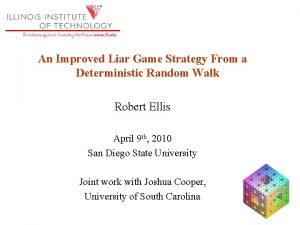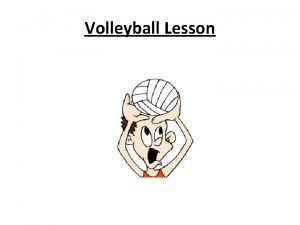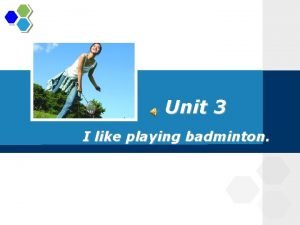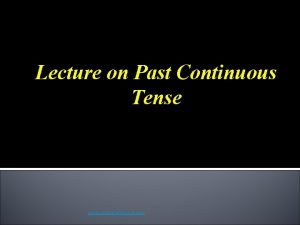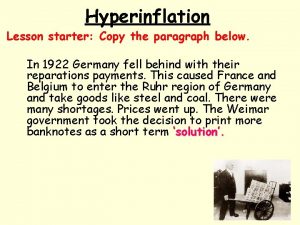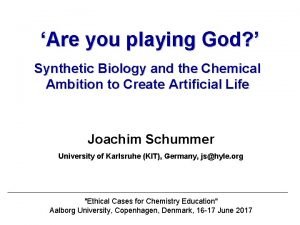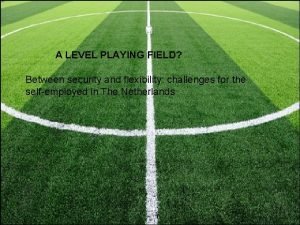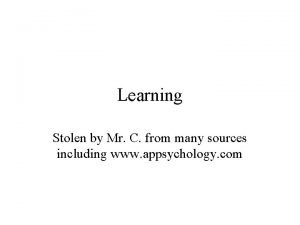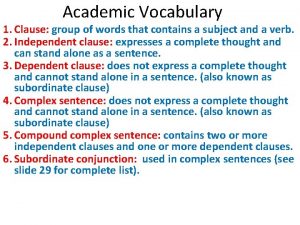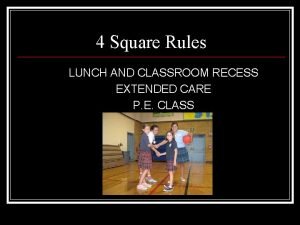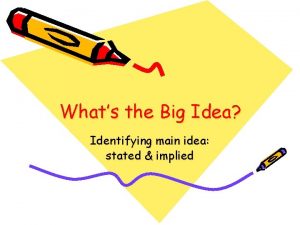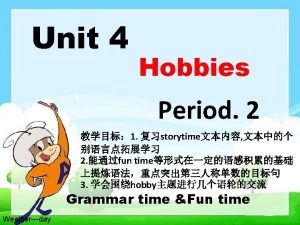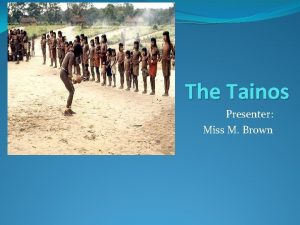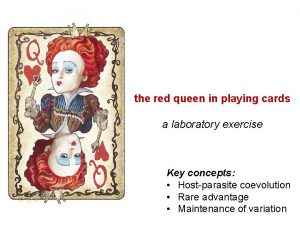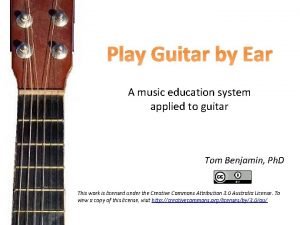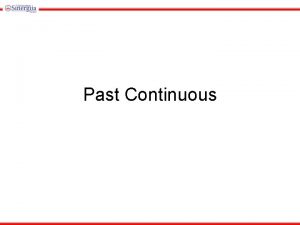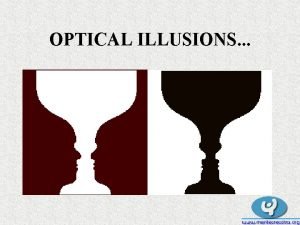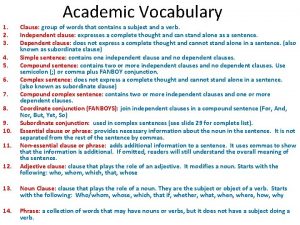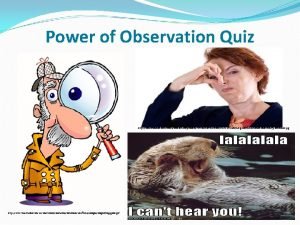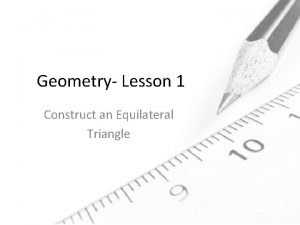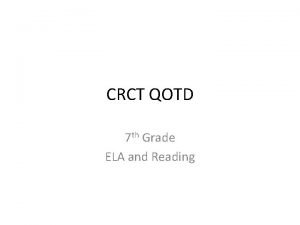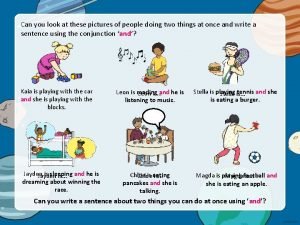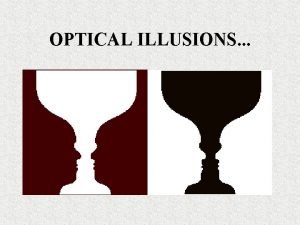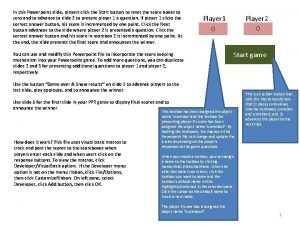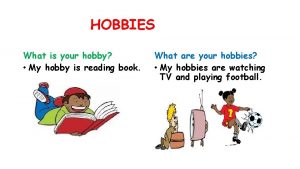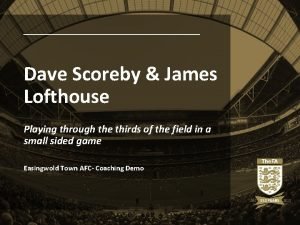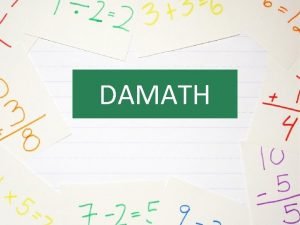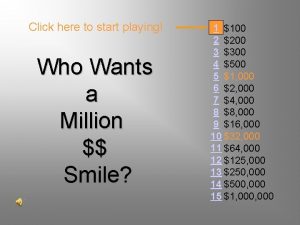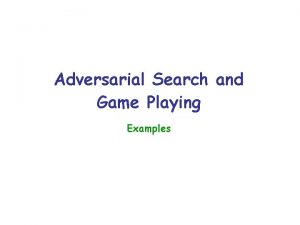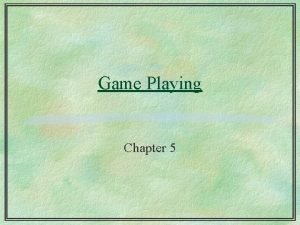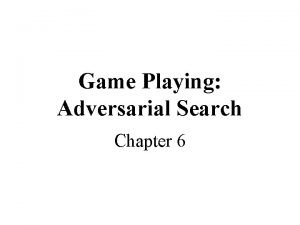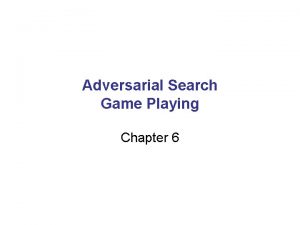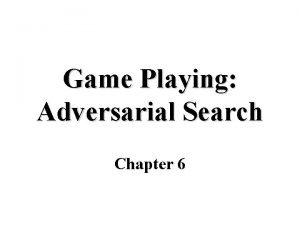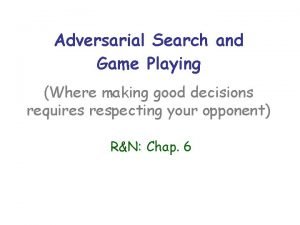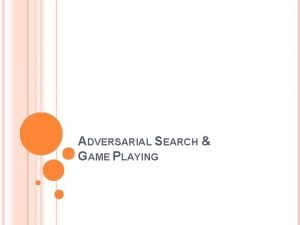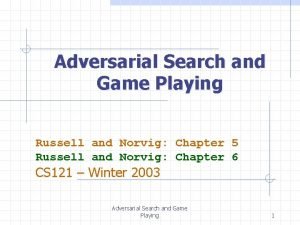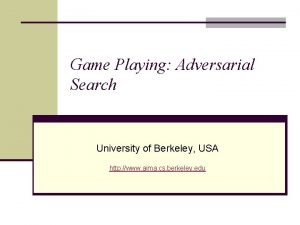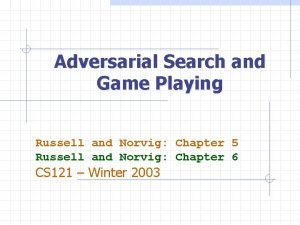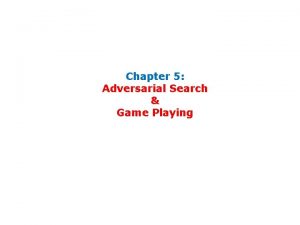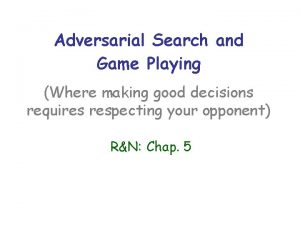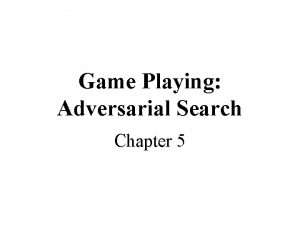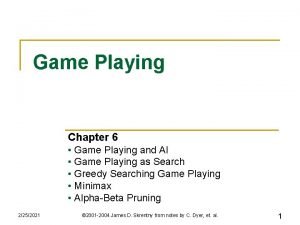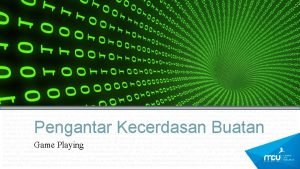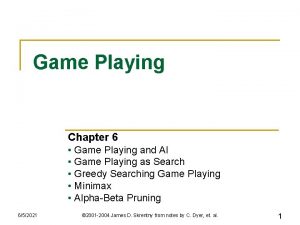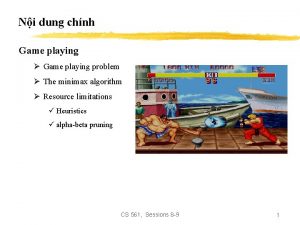Adversarial Search game playing search We have experience
























































































- Slides: 88


Adversarial Search (game playing search) We have experience in search where we assume that we are the only intelligent entity and we have explicit control over the “world”. Let us consider what happens when we relax those assumptions. We have an enemy…

Types of Games Perfect information (fully observable) Deterministic Stochastic Chess, checkers, Go, Tic-Tac-Toe Backgammon, monopoly Imperfect information Battleships (partially observable) Scrabble, poker, bridge Games can also be one, two or multi-player (we focus on two player) Games can be cooperative or competitive (we focus on competitive, or zero-sum, games)

Two Player Games (Deterministic , fully observable) Max always moves first. Min is the opponent. We have • An initial state. Max Vs. Min • A set of operators. • A terminal test (which tells us when the game is over). • A utility function (evaluation function). The utility function is like the heuristic function we have seen in the past, except it evaluates a node in terms of how good it is for each player. Positive values indicate states advantageous for Max, negative values indicate states advantageous for Min. Normally the closer to 1, the better things look for Max, the closer to -1, the better things look for Min.

Two Player Games (Deterministic , fully observable) Max always moves first. Min is the opponent. We have • An initial state. • A set of operators. • A terminal test (which tells us when the game is over). • A utility function (evaluation function). • Sometimes the utility function can double as the terminal test. For example if it returns exactly plus or minus 1.

Adversarial Search Beyond Games • Adversarial search can be applied to economics, business, politics and war! • We will gloss over such considerations here

Tic-tac-toe (noughts and crosses)

Max

Max Min . . . . -1 O 1 Terminal States Utility . .

Max Min . . Max. . -1 O 1 Terminal States Utility . .

Max Min . . Max. . -1 O 1 Terminal States Utility . .

A simple abstract game. Max makes a move, then Min replies. A 11 3 A 12 12 A 13 A 21 8 2 A 3 A 22 A 23 4 A 31 6 14 A 32 A 33 5 An action by one player is called a ply, two ply (a action and a counter action) is called a move. 2

(To help make abstract games more concrete) Imagine a game: Max has a nickel and dime, he must move first, and place any (non-empty) combination of them on the table. Min has a penny, he replies by putting the penny on the table, either heads up, tails up or on its edge. Game over! We look up the payoffs in a table. Payoff Table N, D, Edge: $3 N, D, Heads: $12 N, D, Tails: $12 N, _, Edge: $2 A 1 A 2 A 3 N, _, Heads: $4 etc A 11 3 A 12 12 A 13 A 21 8 2 A 23 4 A 31 6 14 A 32 A 33 5 2

(To help make abstract games more concrete) Imagine a game: Max has 3 Kings, , he places one on the table. Min has the Queen of , he either places it on the table face up, face down, or says “no card!”. Game over! We look up the payoffs in a table. Payoff Table K , Q $3 K , Face down $12 K , No Card! $8 etc A 1 A 2 A 3 etc A 21 8 2 A 23 4 A 31 6 14 A 32 A 33 5 2 No Card 12 A 13 No Card 3 A 12 No Card A 11

A simple abstract game. Max makes a move, then Min replies. A 11 3 A 12 12 A 13 A 21 8 2 A 3 A 22 A 23 4 A 31 6 14 A 32 A 33 5 An action by one player is called a ply, two ply (a action and a counter action) is called a move. 2

The Minimax Algorithm • Generate the game tree down to the terminal nodes. • Apply the utility function to the terminal nodes. • For a S set of sibling nodes, pass up to the parent… • the lowest value in S if the siblings are • the largest value in S if the siblings are • Recursively do the above, until the backed-up values reach the initial state. • The value of the initial state is the minimum score for Max.

3 A 2 A 1 A 3 3 A 11 3 A 12 12 2 A 13 A 21 8 2 A 22 2 A 23 4 A 31 6 14 A 32 A 33 5 2 In this game Max’s best move is A 1, because he is guaranteed a score of at least 3 (In fact, he is guaranteed a score of exactly 3, if he plays a rational opponent)

Although the Minimax algorithm is optimal, there is a problem… The time complexity is O(bm) where b is the effective branching factor and m is the depth of the terminal states. (Note space complexity is only linear in b and m, because we can do depth first search). One possible solution is to do depth limited Minimax search. • Search the game tree as deep as you can in the given time. • Evaluate the fringe nodes with the utility function. • Back up the values to the root. • Choose best move, repeat. We would like to do Minimax on this full game tree. . . … but we don’t have time, so we will explore it to some manageable depth. cutoff

Depth limited Minimax search. • Search the game tree as deep as you can in the given time. • Evaluate the fringe nodes with the utility function. • Back up the values to the root. • Choose best move, repeat. Search to cutoff, make best move, wait for reply… After reply, search to cutoff, make best move, wait for reply…

Example Utility Functions I Tic Tac Toe Assume Max is using “X” e(n) = if n is win for Max, + if n is win for Min, - X O e(n) = 6 - 4 = 2 else (number of rows, columns and diagonals available to Max) - (number of rows, columns and diagonals available to Min) O X X O e(n) = 4 - 3 = 1

Example Utility Functions II Chess I Assume Max is “White” Assume each piece has the following values pawn = 1; knight = 3; bishop = 3; rook = 5; queen = 9; let w = sum of the value of white pieces let b = sum of the value of black pieces e(n) = w - b w + b Note that this value ranges between 1 and -1

Example Utility Functions III Chess II The previous evaluation function naively gave the same weight to a piece regardless of its position on the board. . . Let Xi be the number of squares the ith piece attacks e(n) = piece 1 value * X 1 + piece 2 value * X 2 +. . . I have not finished the equation. The important thing to realize is that the evaluation function can be a weighted linear function of the pieces value, and its position.

Utility Functions We have seen that the ability to play a good game is highly dependant on the evaluation functions. How do we come up with good evaluation functions? • Interview an expert. • Machine Learning.

Take Home Message We cannot beat Minimax (but see Alpha-Beta below) for exact game playing. All our time should be spent on better utility functions Just like We cannot beat A*, all our time should be spend on better heuristic functions

Alpha-Beta Pruning I We have seen how to use Minimax search to play an optional game. We have seen that because of time limitations we may have to use a cutoff depth to make the search tractable. Using a cutoff causes problems because of the “horizon” effect. Is there some way we can search deeper in the same amount of time? Yes! Use Alpha-Beta Pruning. . . Best move before cutoff. . . … but all its children are losing moves Game winning move.

Alpha-Beta Pruning II If you have an idea that is surely bad, don't take the time to see how truly awful it is. Pat Winston 3 A 1 A 2 2 3 A 11 3 A 12 12 A 3 A 21 A 13 8 2 A 23 2 A 31 14 A 32 A 33 5 2 Stops completely evaluating a move when at least one possibility has been found that proves the move to be worse than a previously examined move.

Alpha-Beta Pruning III Effectiveness of Alpha-Beta · Alpha-Beta is guaranteed to compute the same Minimax value for the root node as computed by Minimax · In the worst case Alpha-Beta does NO pruning, examining bd leaf nodes, where each node has b children and a d-ply search is performed · In the best case, Alpha-Beta will examine only 2 bd/2 leaf nodes. Hence if you hold fixed the number of leaf nodes then you can search twice as deep as Minimax! ·The best case occurs when each player's best move is the leftmost alternative (i. e. , the first child generated). So, at MAX nodes the child with the largest value is generated first, and at MIN nodes the child with the smallest value is generated first. This suggest that we should order the operators carefully. . . In the chess program Deep Blue, they found empirically that Alpha-Beta pruning meant that the average branching factor at each node was about 6 instead of about 35 -40

Here is a trivial, but legal example. Max makes a move, and the game is immediately over! What should Max do? B (5) A C (100) D (-7)

Max should move to C, and win 100 dollars A B (5) 100 C (100) D (-7)

A more interesting game Max has three choices, and depending on what he does, Min has 2 or 3 choices of a reply What should Max do? A B C E (4) F (5) G(6) D H (2) J (45) K (3) L (8) Let us use Alpha-Beta pruning to find out.

First we explore the subtree under B If we moved there, Min could give us 4 dollars, or 5 dollars If we assume that Min in rational, the expected payoff is 4 dollars A 4 B C E (4) F (5) G(6) D H (2) J (45) K (3) L (8) Note that some people would write here <=4 dollars. That is to say, they would label subtree B as four dollars or greater If Max is rational, that is unnecessary

Now we begin to explore the subtree under C, beginning with G If we moved to C, and Min moved us to G, we would get 6 dollars, which is better than 4 This looks promising, so we keep exploring, visiting H If we moved to C, and Min moved us to H, we would get 2 dollars, which is worse than 4 A 4 B C E (4) F (5) G(6) <=2 H (2) D J (45) K (3) L (8) Given this, we don’t care what is in J, we can prune it We push less than or equal to 2 up the subtree to label node C

Finally we begin to explore the subtree under D, beginning with K If we moved to D, and Min moved us to K, we would get 3 dollars, which is worst than 4 Given that, we don’t care what is in L, we can prune it. A 4 B C E (4) F (5) G(6) <=2 H (2) D J (45) <=3 K (3) L (8) Given this, we don’t care what is in J, we can prune it We push less than or equal to 3 up the subtree to label node D

So Max’s best move is to B, and he expects to win 4 dollars A 4 B C E (4) F (5) G(6) 4 <=2 H (2) D J (45) <=3 K (3) L (8)

Here is more complex game tree, the depth and branching factors depend on how we play As before, we will start exploring subtree B. . A B C D H E (4) J F (99) G(6) M (3) N (4) O (7) P (9) K (3) L (8)

Playing B guarantees me 4 dollars If Max pays C and Min tried G, that would be a 6 dollar payoff, better than 4, so we must keep exploring the C subtree… A 4 B C D H E (4) J F (99) G(6) M (3) N (4) O (7) P (9) K (3) L (8)

If Max pays C and Min tried H, then there are two choices for Max The first is M, it only pays 3 dollars But suppose that N paid 10000 dollars! (actually, anything better than 4 would do) We need to find out, so we go to N, and find 4 A 4 B C D H E (4) F (99) G(6) 4 J M (3) N (4) O (7) P (9) K (3) L (8)

…we need to find out, so we go to N, and find 4 At this, I can prune the J subtree. It does not help me to know what the values there are A 4 B C <=4 H E (4) F (99) G(6) 4 D J M (3) N (4) O (7) P (9) K (3) L (8)

Finally , we need to visit the D subtree As soon as we explore K and find its value is 3 we can prune the rest of the subtree A 4 B C <=4 H E (4) F (99) G(6) 4 D <=3 J M (3) N (4) O (7) P (9) K (3) L (8)

Thus Max’s best move is to pay B, and he expects to win 4 dollars A 4 B C 4 <=4 H E (4) F (99) G(6) 4 D <=3 J M (3) N (4) O (7) P (9) K (3) L (8)

Use Minimax or Alpha-Beta, but don’t search so deep… 4 -ply ≈ human novice 8 -ply ≈ typical PC, human master 12 -ply ≈ Deep Blue, Kasparov Grandmaster Master Beginner

Solved Games A solved game is a game whose outcome (win, lose, or draw) can be correctly predicted from any position, given that both players play perfectly. Games which have not been solved are said to be "unsolved". The most obvious way to solve a game, is to run the Minimax Algorithm all the way to the leaf nodes, and back up the scores to the root node. At that point, there are only three options: • It is a win for first player. • It is a win for second player. • It is a draw. It is rare we can actually do this full search to the leaf nodes.

The backed up utility function (evaluation function) for Tic-tac-toe is zero. In other words, a draw. To put it another way, if god A played this game with god B a trillion times, the outcome would always be a draw. Thus we say, Tic-tac-toe is solved A solved game is a game whose outcome (win, lose, or draw) can be correctly predicted from any position, given that both players play perfectly. 0

Remember our toy example? It is solved. It is a win for Max (a win of 3) 3 A 2 A 1 A 3 3 A 11 3 A 12 12 2 A 13 A 21 8 2 A 22 2 A 23 4 A 31 6 14 A 32 A 33 5 2

Here is a different toy example It is solved. It is a loss for Max (a loss of 1 for Max, or a win for Min of 1) -1 A 2 A 1 -1 A 12 12 A 3 -44 A 13 A 21 8 2 A 22 -44 A 23 -9 A 31 6 0 A 32 -9 A 33 10, 000

Hex is solved Hex is a win (for Max) One way to solve a game is to build the entire search tree and run Minimax on it. However sometimes that is not necessary…

Chopsticks is Solved (Swords, Sticks, Split, Cherries and Bananas) Chopsticks is a loss (for Max) Players extend a number of fingers from each hand transfer those scores by taking turns to tap one hand against another.

Checkers is Solved! Checkers is a draw The game of checkers has roughly 500 billion possible positions (5 × 1020). The task of solving the game, determining the final result in a game with no mistakes made by either player, is daunting. From 1989 to 2007, almost continuously, dozens of computers have been working on solving checkers, applying state-ofthe-art artificial intelligence techniques to the proving process.

Chess is not Solved I Will chess ever be solved? One estimate is that it will be solved in 2250 (about 200 years) assuming Moore’s law holds all that time!!

Chess is not Solved II However, every endgame, with 7 pieces or fewer has been solved! This does not help that much, since most games are over long before we get down to 7 pieces. All 4 -piece endgames were solved in the late 80 s In the early 90 s, all 5 -piece endgames were solved In 2005, all 6 -piece endings were solved. In 2012, all 7 -piece endings were solved. The computer memory required for all 7 -piece endings is 140 terabytes.

Games With Chance • Consider backgammon – A die roll determines the moves a player can make – Alternates moves and die rolls • Representation – Add chance nodes to the game tree

Chance Nodes Note that different games can be: Chance, Max, Min, . . Max, Chance, Min, Chance, Max, Chance, Min, . . Max, Min, Chance, . . Max Chance … 1/6 1 1/6 2 … 1/6 3 P(s) = Probability of roll Value of roll

Note that different games can be: Chance Nodes Chance, Max, Min, . . Max, Chance, Min, Chance, Max, Chance, Min, . . Max, Min, Chance, . . Max Chance … 1/6 1 1/6 2 … 1/6 3 P(s) = Probability of roll Min … … Chance … … … (The interleaving depends on the game) Value of roll

Expectminimax Value • Extend minimax idea to chance nodes – Expectiminimax value P(s) is the probability of a random event (e. g. , die roll) occurring • Time complexity – O(bmnm), where n is the number of distinct events – a-b pruning can be extended, but still enormous time complexity

Very nice visualization of Chess Search The machine's thoughts, endgame The machine foresees that white's pawn will become a queen, and dominate the board as the black king flees. www. turbulence. org/spotlight/thinking/chess. html

Checkers: Tinsley vs. Chinook The average branching factor for checkers is about 10. The effective tree depth is about 40 Chinook is the first computer program to win the world champion title in a competition against humans. Chinook was declared the Man. Machine World Champion in checkers in 1994 Tinsley suffered loss to Chinook Marion Tinsley (1927 – 1995) is considered the greatest checkers player who ever lived. He was world champion from 1955– 1958 and 1975– 1991. Tinsley never lost a World Championship match, and lost only five games (to humans) in his entire 45 year career.

Othello: Murakami vs. Logistello 1997: The Logistello software crushed Murakami by 6 games to 0 The average branching factor for Othello is about 7. The effective tree depth is 60, assuming that the majority of games end when the board is full. Logistello software written by Michael Buro Takeshi Murakami: World (Human) Othello Champion

Chess: Kasparov vs. Deep Blue 1997: IBM Deep Blue wins by 3 wins, 1 loss, and 2 draws The average branching factor for chess is about 36. The effective tree depth is about 40

Go: Goemate vs. ? ? Chen Zhixing Author of Goemate (arguably the best Go program available today) e t a d f o ut o s i e lid s s i h t e, e s l l a sh As we Gave Goemate a 9 stone handicap and still easily beat the program, thereby winning $15, 000

Adversarial Search: Revisted (game playing search) We have experience in search where we assume that we are the only intelligent entity and we have explicit control over the “world”. Let us consider what happens when we relax those assumptions.

Example Utility Functions II Chess I Assume Max is “White” Assume each piece has the following values pawn = 1; knight = 3; bishop = 3; rook = 5; queen = 9; let w = sum of the value of white pieces let b = sum of the value of black pieces e(n) = w - b w + b Note that this value ranges between 1 and -1

Depth limited Minimax search. • Search the game tree as deep as you can in the given time. • Evaluate the fringe nodes with the utility function. • Back up the values to the root. • Choose best move, repeat. Search to cutoff, make best move, wait for reply… After reply, search to cutoff, make best move, wait for reply…

Branching Factor Average game length Game-tree complexity Checkers 8 Chess Go 35 70 1031 The Game-tree complexity of Go is about 2787 times that of Chess. So even if Moore's law holds out forever, it would take about 700 years for Alpha -Beta to be competitive here. 250 123 150 10123 10360

Super Human Performance “Although progress has been steady, it will take many decades of research and development before world-championship– caliber go programs exist”. Jonathan Schaeffer, 2001 Checkers Chess Go 1994 1997 ? “It may be a hundred years before a computer beats humans at Go—maybe even longer. ” Dr. Piet Hut, 1997

Exhaustively calculating the first eight moves would require computing 512 quintillion (5. 12× 1020) possible combinations. As of March 2014, the most powerful supercomputer in the world, NUDT's "Tianhe-2", can sustain 33 petaflops. At that rate, even given an exceedingly low estimate of 10 operations required to assess the value of one play of a stone, Tianhe-2 would require 4 hours to assess all possible combinations of the next eight moves in order to make a single play. Some Concrete Numbers Go ? 8

We have good utility functions for Checkers, Chess etc. What about Go? All utility functions tend to work better, the deeper you are in the tree. Even if we could get a supercomputer, and we could wait four hours, we would find that the utility function is basically the same for all nodes on the horizon! So we have no information to make an informed choice. 8

Monte Carlo Tree Search Intuition Imagine the following: We are playing Go, and we need to choose between two moves, one is the move that is to the root of the red subtree, the other is the move that is to the root of the blue subtree. The best evaluation function basically says “I have no idea which is better, maybe flip a coin? ” It happens to be true (but we have no way to know this) that: • 90% of the terminal nodes in Red are wins for white (Max) • 50% of the terminal nodes in Blue are wins for white (Max) So, all things being equal, Red is a much better choice. Red Blue

Suppose we started at the root of Red, and randomly traversed down the tree to a terminal node. What is the probability that this terminal node is a win for white (Max)? It is 0. 9 If I did the same for the Blue subtree, what is the probability that this terminal node is a win for white (Max)? It is 0. 5

Suppose I do this multiple times, lets say ten times, what is the expected number of wins for White (Max)?


Think of as: 9/10 = 90% So 90% of the games that pass through this node are wins for Max 9/10 Likewise 6/10 = 60% So 60% of the games that pass through this node are wins for Max 6/10 Note that the correct value is 50%, but our estimate of 60% is pretty close Red Blue

Monte-Carlo tree search (MCTS) Until we run our of time (lets say one minute) MCTS repeats four phases: descent, roll-out, update, and growth. • descent phase: expand current node • roll-out phase: play n random games from each leaf node (in my example, n = 3) • update phase: the statistics (number of wins) are passed up the tree. • growth phase: expand the most promising node.

descent phase

roll-out phase Random Game 1: Win for white

roll-out phase Random Game 2: Win for black Random Game 1: Win for white

roll-out phase Think of as: 2/3 =66. 6% So 66. 6% of the games that pass through this node are wins for Max 2/3 Random Game 2: Win for black Random Game 1: Win for white Random Game 3: Win for white

roll-out phase 2/3 3/3 Random Game 3: Win for white Random Game 1: Win for white Random Game 2: Win for white

update phase We can update the ancestor node(s) So 7/12 of the games that pass through the root are wins for Max 2/3 7/12 3/3 1/3

growth phase 7/12 2/3 3/3 1/3

roll-out phase 7/12 2/3 3/3 1/3 1/3

update phase 8/15 2/3 4/6 1/3 1/3

growth phase 8/15 2/3 4/6 1/3 1/3

roll-out phase 8/15 2/3 3/3 4/6 1/3 1/3

update phase 11/18 5/6 3/3 4/6 1/3 1/3

11/18 5/6 3/3 4/6 1/3 1/3 Stop! We ran out of time, our one minute is up. Of our four options, one has a the highest estimated probability of a win (5/6), so that is our move.

11/18 5/6 4/6 1/3 1/3 We wait a minute for Min to make his move. He choses the bold circle. This now becomes the root of our new search tree, and we begin our one minute of MCTS again….

When will AI Go be superhuman? I found this chart of progress in 2013, so it extrapolated it (next slide)…. Zen 19 ratings over time on KGS Go servers. Data from KGS (2010, 2013 a). Adapted from: Algorithmic Progress in Six Domains. Katja Grace There about 100 USA players at 5 dan or above

When will AI Go be superhuman? It predicted human equivalence around 2017 9 Best Humans 2014 In the 2017 Future of Go Summit, Alpha. Go beat Ke Jie, the world No. 1 ranked player at the time, in a three-game match. 2015 2016 2017
 Adversarial search problems uses
Adversarial search problems uses Playing a decent game of table tennis
Playing a decent game of table tennis The most dangerous game flashback
The most dangerous game flashback Segundo o estudo sobre past continuous
Segundo o estudo sobre past continuous Jillian and dawn are playing a game
Jillian and dawn are playing a game Greek vase shapes
Greek vase shapes Imprinting meaning psychology
Imprinting meaning psychology Early experience vs later experience debate
Early experience vs later experience debate Direct experience and indirect experience
Direct experience and indirect experience 8 vertices 12 edges
8 vertices 12 edges Adversarial stakeholders
Adversarial stakeholders The adversarial system
The adversarial system Accusatorial system
Accusatorial system Sigir 2018
Sigir 2018 Pgd
Pgd Quantum generative adversarial learning
Quantum generative adversarial learning On adaptive attacks to adversarial example defenses
On adaptive attacks to adversarial example defenses Adversarial interview
Adversarial interview Adversarial system law definition
Adversarial system law definition Adversarial examples
Adversarial examples Generative adversarial network
Generative adversarial network Spectral normalization
Spectral normalization Conditional generator
Conditional generator Adversarial multi-task learning for text classification
Adversarial multi-task learning for text classification Adversarial training
Adversarial training Adversarial training
Adversarial training Nicolas papernot
Nicolas papernot The limitations of deep learning in adversarial settings
The limitations of deep learning in adversarial settings Adversarial patch
Adversarial patch Melody randford
Melody randford Pirate game game theory
Pirate game game theory The farm game board game
The farm game board game A formal approach to game design and game research
A formal approach to game design and game research Game lab game theory
Game lab game theory Liar game game theory
Liar game game theory Liar game game theory
Liar game game theory Diagram on the playing area in volleyball
Diagram on the playing area in volleyball Do you like playing badminton
Do you like playing badminton Ajax and achilles
Ajax and achilles Telephone conversation role play
Telephone conversation role play What s your hobby
What s your hobby Direct speech into reported speech
Direct speech into reported speech Role-playing dimensions power bi
Role-playing dimensions power bi Playing nice in the sandbox
Playing nice in the sandbox Devil and god playing chess
Devil and god playing chess Performance marketing meaning
Performance marketing meaning Past continuous tense
Past continuous tense German kids playing with money
German kids playing with money Barry liked playing board games
Barry liked playing board games Playing god (ethics)
Playing god (ethics) Even playing field meaning
Even playing field meaning My hobby is keeping fish. i have a modest
My hobby is keeping fish. i have a modest Garcia effect
Garcia effect Genevieve was obsessed with details
Genevieve was obsessed with details Older television sets had tubes
Older television sets had tubes Four square snake eyes
Four square snake eyes Two types of main idea
Two types of main idea She likes playing table tennis.
She likes playing table tennis. Materials used to make taino houses
Materials used to make taino houses Red queen in deck of cards
Red queen in deck of cards Sintaks role playing
Sintaks role playing Playing guitar by ear
Playing guitar by ear (+) they played football last month
(+) they played football last month When i phoned
When i phoned Hardest illusion
Hardest illusion I am play football
I am play football Quia conjunctions rags to riches
Quia conjunctions rags to riches Children playing
Children playing I like playing tennis
I like playing tennis Msn quiz
Msn quiz This organization put on a barbecue every summer
This organization put on a barbecue every summer Lesson 1 construct an equilateral triangle
Lesson 1 construct an equilateral triangle Basketball playing time
Basketball playing time In paragraph five, the word navigable means
In paragraph five, the word navigable means Look at these pictures.
Look at these pictures. Can you spot the elephant in this optical illusion
Can you spot the elephant in this optical illusion Soccer players learn many skills when playing soccer
Soccer players learn many skills when playing soccer Let's enjoy playing
Let's enjoy playing Play therapy definition
Play therapy definition Your score: 1 click here to start playing
Your score: 1 click here to start playing My hobbies is
My hobbies is Playing through the thirds
Playing through the thirds Online damath game
Online damath game Click here to start playing
Click here to start playing Space complexity bfs
Space complexity bfs Unified search vs federated search
Unified search vs federated search èinterest
èinterest Federated search vs distributed search
Federated search vs distributed search What is informed search and uninformed search
What is informed search and uninformed search
